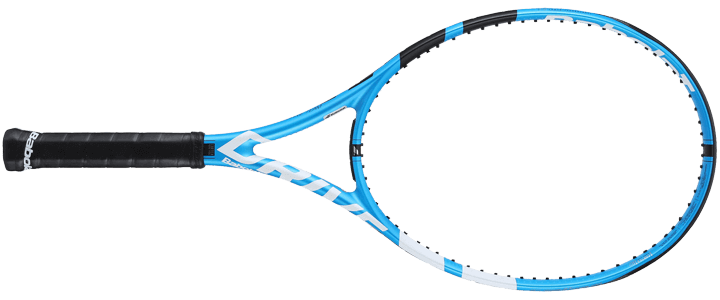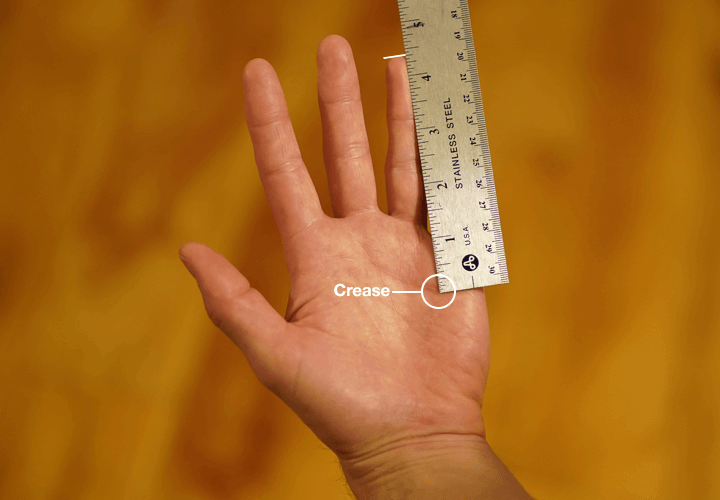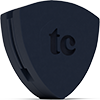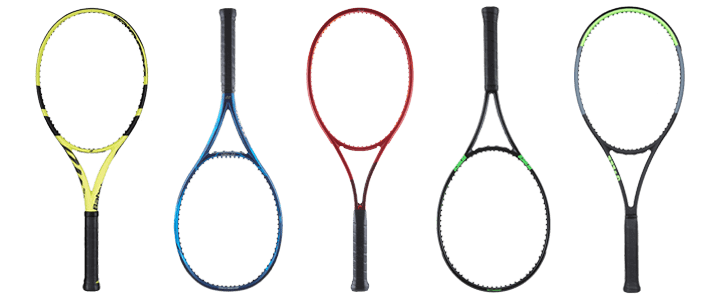Check out my custom vibration dampener
How to Choose a Tennis Racquet
A guide to selecting the perfect fit
We hope you love this article. Just so you know, TennisCompanion may collect a small share of sales from the links on this page to help keep this site running. Learn more.
There are more tennis racquets on the market than ever, and while it’s great there’s such a wide selection of racquets to choose from, it can be challenging to decide which racquet is best for you.
Generally, when buying a racquet, you need to decide if you value power, control, or something in between. Finding the racquet that best complements your level and style of play takes thoughtful consideration, but we’ve laid out a complete buying guide to help you make the process as simple as possible.
Whether you’re an intermediate player that’s in the process of stepping up their game or are an absolute beginner, our guide will teach you how to choose the right tennis racquet to optimize your performance. Ready to find out what racquet you should be using? Let’s get started!
Article Contents
Click below to jump to a section
Tap below to jump to a section
Tennis Racquet Parts
Choose by Skill Level
Types of Tennis Racquets
How to Choose a Grip size
Head Sizes & Length
Weight, Balance & Stiffness
Popular Racquet Brands
Men’s vs. Women’s Racquets
Racquet Price Ranges
Kids Tennis Racquets
Racquet Demo Programs
Selecting Tenis Strings
New to TennisCompanion?
Create a free account and explore my latest videos below
Tennis Racquet Parts
To start, let’s do a quick breakdown of each part of your tennis racquet to help you understand the basic terminology.
Learning the basics can help you make a more informed purchase.

The Head
The head of the racquet is the part that includes the strings and the frame around them. Most racquet heads are between 95-110 square inches. A bigger head gives you more power while sacrificing control. Likewise, a smaller racquet gives you more control but less power.
Throat
You’ll find the throat between the bottom of a racquet’s head below and the top of a racquet’s handle.
Shaft
The shaft is the part of the racquet below the head that contains the throat and handle. It extends to the butt at the end of the racquet.
Handle
The handle is the part of the racquet you hold while playing. Most handle sizes (measured in circumference) range from about 4 inches to 4 ¾ inches.
Grip
The grip is the cover that goes over your racquet’s handle. You can add a replacement grip or an overgrip to change the feel, improve traction, or increase the size of the handle slightly.
Butt
The butt is at the bottom of the handle and is slightly wider than the rest to ensure a solid grip – it also contains the butt cap at the bottom. You can open the butt cap on many racquets to add weight and change your racquet’s balance.
Other Parts of Your Racquet
You might also come across these terms when researching racquets.
- Beam: Refers to the thickness of your racquet head
- Bumper Guard: A cover around the edge of your racquet’s head the to protect it
- Grommets: Pieces of plastic found around the outer edge and through the holes of the frame to protect the strings
Read our full article on racquet parts for more detail.
Choose a Racquet by Skill Level
The further along you progress in your tennis career, the more important choosing the perfect racquet becomes.
When you’re first learning how to play tennis, you’ll make more significant improvements in your game through regular practice than by buying expensive gear.
If you gave Federer a $20 racquet, and you gave a novice the most expensive racquet in the world, who do you think would win a match?
There’s no replacement for hard work, but the proper racquet can help maximize your potential.
Beginners
If you’re a beginner looking for a new racquet, the exact specs of your frame are less important than making sure it’s comfortable and not too heavy.
It’s tempting to start with an expensive racquet loaded with features or to copy the model your favorite player uses. However, this strategy can hurt your game because you’ll likely end up choosing a racquet that you don’t have the skill to use properly.
One of the first things you should check when using a new racquet is the grip size. Using the proper grip size lowers your risk of developing hand or arm issues and gives you a more solid grasp. Don’t worry if you don’t know how to find what size you should be using. We’ll explain the process of finding your grip size later in this article.
Beginners often do best with racquets that have a head size larger than 100 square inches. The large head gives you a big target to hit the ball with and increases the size of the sweet spot.
The downside of using a bigger head is the additional size means you’ll have to sacrifice some control. However, if you’re a novice, it’s a tradeoff that will likely improve your game during the learning stages.
Another important factor to consider is the weight of your racquet. If you’re a beginner, it’s a good idea to stick with a racquet under roughly 11 ounces (312 grams). Racquets generally start at about 8 ounces (227 grams). If you’re a smaller person, you might want to start with a racquet on the lower end of this weight range. A light racquet is easier to maneuver and can help prevent injury from using a racquet that’s too heavy.
Here are a few other racquet attributes beginners do well with (we’ll explain what each of these means in more detail in the sections to follow):
- Oversized head
- Extended length
- Stiffer frame
- Lightweight construction
Popular Beginner Racquets
| Name of Racquet |
| Head Titanium Ti.S6 |
| Wilson Hyper Hammer 5.3 |
| Wilson Ultra 110 |
| Babolat Boost Drive |
| Babolat Boost Aero |
Intermediate
Once you’ve made it past the beginner stage, you’ll have more control over your shots and will be better at producing power. If you’re at the intermediate level, you’ll likely want to start experimenting with smaller head sizes and heavier racquets.
If you opted for a larger head size as a beginner, then you might want to move down to racquet’s in the 98 to 100 square inch range for extra control as an intermediate player.
You’ll typically find intermediate level racquets with medium head sizes while maintaining solid maneuverability and sacrificing some power. However, if you’ve been playing for a while, you’re likely able to produce more power yourself than when you were a beginner to make up the difference.
You can also try moving up to a slightly heavier racquet if you feel like you have the strength to use it. The heavier racquet will give you more stability when you hit the ball. You may also want to experiment with several other aspects of your racquet, including going with a heavier swingweight, using a more flexible frame, and trying a tighter string pattern. We’ll cover each of these attributes later in this guide.
Popular Intermediate Racquets
| Name of Racquet |
| Babolat Pure Aero 2019 |
| Babolat Pure Strike |
| Wilson Clash 100 |
| Wilson Pro Staff 97L |
| HEAD Graphene 360 Speed Pro |
Advanced
If you’ve been playing tennis competitively for years, you probably already have a good idea of what type of player you are. Advanced players have more strength, better stamina, and more control than lower level players. If you’re at this level, you can handle heavier racquets and smaller head sizes.
However, just because you can use smaller and heavier racquets doesn’t mean you should. Ultimately, the racquet you should be playing with is the one that feels the best to you.
If you’re at this level, you’ll improve your game the most by matching your style of play to the type of racquet you’re using and tweaking the specs to maximize your performance.
Almost all advanced players go with a control (player’s racquet) or a modern player’s racquet. If you have the technique that allows you to generate plenty of power, you might want to go with a control racquet. If not, there are different types of racquets for you to choose from.
Popular Advanced Racquets
| Name of Racquet |
| Wilson Pro Staff RF97 |
| Wilson Blade v8 98 |
| YONEX Vcore Pro 97 310g |
| HEAD Graphene 360+ Gravity Pro |
| HEAD Graphene 360+ Prestige Mid |
Let’s walk through each of those next.
Types of Tennis Racquets
In order to help players navigate the plethora of options on the market, we can categorize racquets into a few different buckets.
Pre-strung and Inexpensive Racquets
If you’re on a budget or you’re not convinced you’re going to love tennis, you can start with a cheap tennis racquet.
As a beginner player, buying expensive equipment won’t have a dramatic effect on your performance. Instead, your technique and the amount you practice will make all the difference.
Racquets on the cheaper side generally come pre-strung, so you can start playing with them right off the shelf. Plus, almost all of the major racquet brands sell racquets for under $80.
Premium Racquets
If you have a little extra to spend or you’ve refined your skills and moved past the level of a beginner, you’ll find there are four different types of premium racquets: power, control (player), tweener, and modern player’s racquets.
Power Racquets

Power racquets, like the Wilson Hyper Hammer 5.3 featured above, have larger heads than the other two types of racquets and are generally lighter (usually under 9.5 ounces). They’re often stiffer to reflect more energy to the ball when you hit and have their balance closer to the head for a higher swingweight.
Power racquets are suitable for players with compact, slow swings. If you’re a relatively small player or aren’t as physically strong as other players, you might like this kind of racquet since it helps you increase your power output.
To summarize, power racquets generally have the following attributes:
- Oversized head
- Extended length
- Stiffer frame
- Lighter construction
They make a great choice for players who are:
- Learning how to play
- Smaller in height
- Looking for power
Control Racquets

Control racquets trade power for control and are generally suitable for advanced players because their small heads and heavier weight require a high level of precision to hit the sweet spot consistently. Featured above is the Head Graphene 360+ Prestige Mid.
Compared to power racquets, they generally have heavier frames to increase stability and more flexibility in the frame to reduce power and allow you to have better placement of the ball.
Control racquets usually have the following attributes:
- Smaller heads
- Standard length
- Flexible frames
- Heavier construction
Control racquets are ideal for players who are:
- Experienced players
- Taller in height
- Looking for control
Tweener Racquets

The specs of a tweener racquet fall somewhere between those of the power and control racquets. Most of the attributes, including head size, stiffness, length, and weight, fall somewhere in the mid-range. The Babolat Pure Drive Team is a great example.
They’re generally light or moderately heavy (9.6 to 11.5 ounces) and have a relatively neutral balance. The head size usually falls between 98 – 104 square inches (632.3 – 671.0 square centimeters).
They make a solid choice for players who:
- Are looking to upgrade from a beginner’s racquet
- Seek a balance of power and control
Modern Player’s Racquets

In today’s modern game of tennis, a new type of racquet has evolved to suit the aggressive hitting style and heavy topspin used by the pros.
Modern player’s racquets feature heavier weight, but slightly larger head sizes and stiffer frames that offer power great topspin. The Head Graphene 360+ Gravity MP feature above is one example.
How to Choose a Grip Size
Tennis racquet grip sizes range from 4 inches to about 4 ¾ inches. The size of your hands helps determine the ideal size grip you should use for the most comfortable fit and prevent injury.
If it’s too small, you won’t have a solid grip, which can lead to injury from over-gripping, while a grip that’s too large can put extra stress on your arm muscles and won’t be comfortable.
There are several ways to measure your grip size. Arguably the easiest way is to measure your hand with a ruler or measuring tape.
- Look for the prominent crease that run through the top of your palm
- Line up your measuring tape or ruler with the edge of your ring finger
- Measure from the top of your ring finger to the crease in your palm. The measurement should be somewhere between 4 and 4 ¾ inches.

You may also want to try a racquet one size above and below the size you measure to see how they feel. When buying a racquet, it’s easier to make the grip bigger than smaller. Adding an overgrip to your racquet will increase the grip size by roughly 1/16 of an inch.
It’s most important to remember that your grip should feel good. While we can guide you to the approximate size that you should start with, it ultimately comes down to personal preference.
Racquet Head Sizes & Length

Two factors to consider when selecting a racquet are the length and head size. Adult tennis racquets range from about 27-29 inches in length, with 29 inches being the maximum allowed in competition.
Longer racquets give you more power since the racquet provides more leverage to hit the ball. A shorter racquet gives you more control at the sacrifice of power.
As we touched on when we talked about the pros and cons of the different types of racquets, the length that’s best for you depends on your physical stature and style of play. If you have trouble producing power, a longer frame will help make up for it and vice versa.
Racquet head sizes range from:
- 85-97 in² for mid-sized racquets
- 98-104 in² for mid-plus racquets
- 105+ in² for oversized racquets
When you’re starting, choosing a racquet over 100 inches increases your margin for error and makes it easier to hit the sweet spot consistently.
However, as you progress and you’re better able to pinpoint your shots, you might want to experiment with smaller head sizes to see if your game benefits from the added control.
Racquet Weight, Balance, and Stiffness

When you’re in the market for a racquet, it’s important to consider the racquet weight, balance, and stiffness to choose the right fit.
Weight
As you become a more skilled and physically stronger player, you may grow into heavier racquets. Most of the racquets you’ll see on the market are between 8 and 13 ounces (227 and 369 grams).
Lighter racquets give you more maneuverability but aren’t as stable when you hit the ball. Heavy racquets give you more control and less vibration or shock, but they’ll add strain to your arm and wrist and lead to fatigue quicker.
Racquet Balance
The center of mass of your racquet is the point in the middle where you would be able to balance it on your finger without it falling.
Racquets that have their center of mass shifted toward the handle are known as head light. These racquets tend to be heavier, which helps absorb and reduce shock while maintaining maneuverability by keeping most of the weight in your hand.
Racquets that have their center of mass shifted toward the head are known as head heavy. These racquets tend to be lighter, which helps ensure they’re maneuverable while increasing power and maintaining reasonable stability with more weight at the head.
Balanced racquets equally distribute weight throughout.
You can adjust the balance by adding lead tape strategically to different parts of your racquet. For example, some players like to add lead tape at the 10 and 2 o’clock positions of their racquet’s frame to add stability and reduce twisting that can occur while hitting.
Tennis Racquet Stiffness
Often overlooked, tennis racquet stiffness is a spec that can change the feel of your racquet and the way it plays.
Imagine bouncing a rubber ball against a carpeted floor and a tiled floor. In which situation will the ball bounce higher?
A stiffer racquet is like a hard tile floor. It allows more energy to transfer back into the ball, i.e., more power.
A more flexible racquet won’t give you the same level of power. However, because it absorbs energy, a flexible racquet gives you better control.
Popular Racquet Brands

There are more than 15 brands of tennis racquets on the market. Here’s a list of some of the more common brands.
Babolat Racquets
Babolat is a French company that was founded in 1975 in Lyons and is one of the big three in terms of popularity along with Wilson and Head. Babolat racquets range from about $30 to upwards of $200.
Wilson Racquets
Wilson originated in the early 1900s in America. Some of the most successful players in the world have used a Wilson racquet, including Roger Federer and his now-famous black RF97. Racquets start at about $30 and can be as much as $300.
Head Racquets
Head is newer to the game than both Wilson and Babolat and originated in America in 1950. It’s now one of the most popular racquets on the market and a popular choice among professionals. The cheapest Head racquets are about $80, and the high-end racquets are around $230.
Yonex Racquets
Yonex is the best-selling Japanese brand of tennis racquets. Like Head racquets, racquets at the bottom of their price range are about $80. Their high-end racquets are around $240.
Tecnifibre
Racquets made by Technifibre start at higher prices because they don’t offer inexpensive aluminum frames but top out at more affordable prices. At the low end, you’re probably going to pay about $120. Techniber’s most expensive racquets are a little over $200.
Men’s vs. Women’s Racquets

Most of the tennis racquets you’ll find on the market are unisex. However, many beginner racquets have an aesthetic targeting, either men or women. Tecnifibre’s T-Rebound TEMPO is one of the only premium racquets on the market made specifically for women.
The average woman on the WTA tour uses a racquet slightly lighter than those used by a man on the ATP tour. However, there are a few exceptions. Serena Williams uses Wilson racquets with a weight of around 11.4 ounces (323 grams).
Another player that’s known for her power on the court, Maria Sharapova, uses a Head racquet that’s about 11.2 ounces (318g). Keep in mind that she’s over six feet tall and one of the stronger women on tour.
If you’re a beginner, you’ll probably do well with a racquet lighter than the ones these two pros use.
Women generally have smaller hands than men as well, so for most women, a grip size between 4 ⅛ inches to 4 ½ inches will be suitable.
Tennis Racquet Price Ranges
You shouldn’t let money stop you or your kids from playing tennis. The price of a racquet varies quite a bit depending on its material and brand, but there are options out there for everyone.
On the low end, pre-strung racquets start at about $20. Of course, the more elaborate the racquet, the higher the price tag. For a top of the line, fully customized racquet, you could end up paying close to $1000.
Of course, generally, the more you pay, the higher the quality racquet you’ll get. However, other factors determine how much racquets costs, including new technologies and its endorsements.
For a beginner, you can purchase your first racquet for under $100. As an intermediate or advanced player, you may pay up to $250 for your racquet. Racquet customization can increase costs further.
How to Choose a Kids Tennis Racquet
Properly sizing a tennis racquet for your child can be tricky. Children develop at different rates, and the racquet size they should be using depends on their stage of growth and development.
To find the very best fit, be sure to check out our complete guide on how to buy a kid’s racquet. However, the key point is that children should start with a smaller tennis racquet and gradually increase as they grow.
Here’s a rough guideline on what racquet length to choose, but again, keep in mind that children who don’t follow the standard growth curve may have to move up or down a size:
Inches
| Age | Height | Racquet |
| 4 or younger | 40 in or less | 19 in |
| 4-5 years | 40-44 in | 21 in |
| 6-8 years | 45-49 in | 23 in |
| 9-10 years | 50-55 in | 25 in |
| 10 or older | 55+ in | 26 in |
Centimeters
| Age | Height | Racquet |
| 4 or younger | 102 cm or less | 48.3 cm |
| 4-5 years | 102-113 cm | 53.3 cm |
| 6-8 years | 114-126 cm | 58.4 cm |
| 9-10 years | 127-140 cm | 63.5 cm |
| 10 or older | 140+ cm | 66.0 cm |
A good test to see if your child is using the right size racquet is to stand the racquet upside-down on the ground with the handle facing upward. Your child should be able to rest their palm comfortably on the butt cap without bending their arm or tipping their body.
It’s also worth noting that most kids racquets come with a standard grip size of 4 inches. If the grip seems too small with the racquet twisting in their hand when they hit, you can build it up by adding an overgrip.
Racquet Demo Programs
When you’re searching for a new racquet, playing with a variety of different styles is the best way to get a feel for each. Many local racquet shops and clubs offer demos of the latest models.
Top online retailers also offer popular demo programs where you can test out a racquet for up to a week. If you choose to buy it, you’ll often receive a discount as well.
Selecting Tennis Strings
Hopefully, by now, you have a strong understanding of how different types of racquets change your game.
Once you have an idea about what kind of racquet you want to play with, you can start looking for strings to match your new racquet if yours didn’t come pre-strung.
Choosing the right strings is a topic worthy of an entirely separate guide, but we’ll cover the basics here.
Types of strings
There are two types of strings: natural gut strings and synthetic. As a novice, you might not notice a big difference, but a more advanced player will be more sensitive to the nuances of different strings.
As their name suggests, natural gut strings come from the gut or intestine of cows. These strings are known for their comfort, feel, and power. The main tradeoff is that they’re relatively expensive compared to synthetic strings.
The most common material for synthetic strings is nylon (synthetic gut), but you can also find them in polyester and Kevlar. Synthetic strings are affordable and offer more variety than natural gut strings.
String Gauge
String gauge refers to the thickness of your strings and is measured on a scale from 13-22, with 22 being the thinnest and 19 being the thickest.
Most strings come at a gauge of 16, 16L, or 17. Thicker strings are more durable and last longer. Thinner strings give you more potential to generate spin. Beginners usually do better with thicker strings for durability, while more advanced players may prefer to make use of the spin potential of thinner strings.
As a new player, don’t assume that thinner strings are going to have you hitting topspin like Nadal. Any player will always generate more topspin through proper technique and racquet head speed, which thinner strings can enhance.
String Tension
The final quality of your strings to consider is string tension, or how tight they fasten to the frame of your racquet.
Low string tension offers more power, while a higher tension will give you better control. Tensions range from about 40 to 65 pounds. Many racquets and strings come with a recommended tension range with the lowest and highest recommended limits.
If you’re unsure of what tension to use for your racquet, we recommend starting in the middle of your racquet’s recommended tension and then adjusting up or down based on your preference for a bit more power or control. As your game develops, you’ll begin to be able to detect the nuance differences in tension.
Wrapping Up
There are hundreds of great tennis racquets on the market, and each has its pros and cons. Everyone has differing physical characteristics and over time develops a unique style of play, which means the best tennis racquet for you might not be the best for anyone else.
For most players, it’s a good idea to start your career with a light racquet with a large head and transition into smaller and heavier racquets as your tennis skills improve. Once you’ve been playing for a few years, you’ll get a better feel for your strengths and weaknesses and develop an idea of what type of racquet will optimize your game.
There are no set rules for choosing a racquet, though. You should make a choice that feels comfortable for you and makes you feel confident in your game. One of the best ways to learn how different types of racquets change the way you play is by trying as many racquets as you can before committing to one.
Have questions about choosing a great racquet? Let us know in the comments below.
Play Better Tennis
Improve your game alongside our community of tennis players
Why join?
Discussion Boards
Join the conversation with other members of the community.
5 Point Friday
Read our weekly recap of the 5 most interesting things we dig up in tennis.



Leave a Reply
Want to join the discussion?Feel free to contribute!